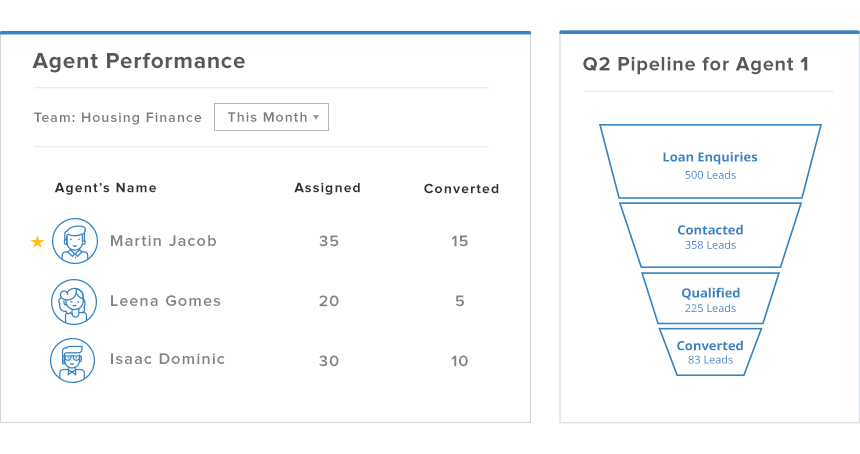When you’re at the helm of your own enterprise, navigating through the stormy seas of competition and customer demands, having a clear understanding of your daily sales performance is not just a luxury; it’s an absolute necessity.
Maintaining a weekly or monthly sales report is easy. But, these reports do not analyze the day-to-day activities of your business. Thus, incapacitating your managers from identifying the operational bottlenecks at the grassroots level.

Businesses have realized that daily sales reports help them understand the challenges of their workforce and suggest corrective measures in time. But, from the salespeople’s perspective, it’s a redundant activity – especially when there is no real update to share. Nonetheless, managers ought to know the daily updates from teams to make informed decisions on how and where to focus their time and resources.
Additionally, preparing sales reports isn’t much work if it is automated. Several organizations use sales CRM software that automatically generates daily sales reports based on business KPIs, and users need not spend any time doing it.
Let’s delve deeper into why daily sales reports are important and how you can make this process a cakewalk.
Why Is a Daily Sales Report Important?
A daily sales report is important because it can help expedite sales performance and the growth of your business. Below given are a few ways how it helps:

1. Helps Shorten the Sales Funnel
Pushing a lead through the sales funnel can be incredibly difficult. It is because not all leads are created equal. You must have a bunch of leads coming in from several sources with different quality scores.
Moreover, the response rate/connect rate for some of these leads might be lower than others. Therefore, without a fast feedback loop, your sales team might end up wasting their time contacting leads from sources that are repeatedly bringing in lower-quality leads.
With a daily sales report that gives you cumulative feedback of the leads that have come in, the contact rates, the quality scores, the lead scores, etc., you’d be able to:
- Automate rules to prioritize high-quality channels/queries at the top of the list while downgrading consistently lower-quality ones.
- Notify sales teams of potential leakage by analyzing “assigned leads vs contacted leads” reports.
- Notify marketing teams about channels that require budget reduction or increase.
This way, with precise sales data, salespeople will be able to reach out to high-quality leads first, reducing the sales cycle altogether
2. Aids Informed Decision-making
The bane of the managerial role is making sound decisions at the right time. While this is already an onerous task, it becomes even worse if the manager does not have enough data to make decisions from.
Who are your regular customers? What is the cash flow? Which part of the business brings more revenue? How many prospects do you have in the pipeline? Why do some team members get high prospects but low conversion? What is your sales team focusing on? Are there any lags you need to amend?
These are some important questions that a manager will have to answer to further push the businesses towards the spotlight.

It is not enough to keep a monthly sales report that barely shows the foundation of each sale and how well your marketing team is performing.
Daily sales reports give you a clear picture of everything that happens both in the office and on the field, making it easy for you to track performances and your customer base.
With daily sales reports, you can easily pinpoint a problem and tackle it before it gets overblown. Also, you can tell where the business is excelling and where to focus more money on. Easy peasy!
3. Monitors and Motivates Salespeople
Believe it or not, challenge motivates your sales and marketing team. By having a sales report that shows who is working hard and well, other team members will also be motivated to do better.
Therefore, you have a bunch of sales reps who are willing to up their game both in the field and in the office. This ultimately leads to increased productivity of your sales team and of course, more sales. It is an all-win situation for you.
4. Saves Time and Resources
This is apparently the most important of all the benefits of daily sales reporting. Time and resources are invaluable to the growth of any business.
However, it is not always a shortage of time or resources that dampens the growth of a business. More often than not, the problem lies with poor management of these two critical growth factors.
Thanks to sales reports, you can now tell which leads are worth pursuing and which should get less time.
Furthermore, you can tell what type of customers patronize your products or services, thus allowing you to know the targeted audience to focus on.
5. Gives Everyday Insights for a Better Performance
While weekly and monthly sales reports are lauded for offering astounding benefits, it is in fact, daily sales reports that actually gives clearer insights into how well the last quarter was, how is the current quarter going, and what the next quarter may look like.

From monthly reports, it is easy to get the gross total and make decisions on a broader scale.
But you may not know which days brought the best sales, what times are best to connect with people, what caused such an increase, and more to achieve even greater sales in the next quarter.
The role of daily sales reports to a business cannot [and we repeat, cannot] be overemphasized.
What Should Be Reported in a Daily Sales Report?
It is not enough to adopt the habit of maintaining regular sales reports. You have to learn how to properly create a sales report and the details that it is supposed to contain. Although these details vary with businesses, here are a few common data points that your sales report should include:
- Number of prospects in the pipeline
- The average time it takes for a lead to complete the sales cycle
- Daily sales goals and quotas
- Number of meetings held daily
- Assigned territories of sales reps
- Average deal size in your pipeline
- Daily conversion rate
- Number of sales negotiations conducted
- Number of opportunities that open and deals that close daily
- Landing page conversion rate
- Number of sales calls and their duration
- Number of queries received
Resource: Masterclass on LeadSquared Reports & Analytics. Also, look at the ready-to-use sales report templates available in LeadSquared CRM.
Top Examples of a Daily Sales Report for Business Growth
A daily sales report is a valuable tool for monitoring the performance and growth of a business. It provides a snapshot of the sales activities and outcomes for a specific day. Here are some top examples of a daily sales report that can help drive business growth:
- Daily Sales Volume: This section of the report focuses on the total sales generated on that particular day. It should break down sales by product, service, or category, giving insights into which offerings are performing well.
Additionally, it should include a comparison to the previous day’s sales and the same day in the previous week or month. This helps identify trends and spot any immediate changes in sales patterns.
Example:- Total Sales for the Day: $15,000
- Comparison to Previous Day: +$3,500 (Growth of 30%)
- Comparison to Same Day Last Week: +$2,000 (Growth of 15%)
- Number of Meetings Set: This section tracks the number of meetings scheduled with potential clients or leads. Meetings are essential for building relationships and converting prospects into customers.
By monitoring meeting numbers, the sales team can gauge their effectiveness in generating interest and engagement with potential clients.
Example:- Number of Meetings Set: 8
- Meeting Types: 5 with Prospects, 3 with Existing Clients
- Number of Sales Opportunities: A sales opportunity is a potential deal in progress where there is a good chance of converting a lead into a paying customer.
Tracking the number of opportunities created each day helps assess the health of the sales pipeline and the team’s ability to nurture leads effectively.
Example:- Number of Sales Opportunities: 12
- Opportunity Stages: 4 in Prospecting, 6 in Proposal, 2 in Negotiation
- Number of Customer Interactions: This section measures the overall engagement with existing customers, including follow-up calls, emails, support interactions, and any other communication.
Satisfied customers are more likely to become repeat buyers and refer others, making this metric vital for customer retention and advocacy.
Example:- Number of Customer Interactions: 25
- Interaction Types: 15 Support Calls, 7 Follow-up Emails, 3 Upsell Conversations
- Number of New Leads Generated: This part of the report focuses on the total number of new leads acquired during the day.
It helps evaluate the effectiveness of lead generation strategies and assess whether the sales team is attracting the right prospects.
Example:- Number of New Leads Generated: 20
- Lead Sources: 10 from Website Form, 5 from Social Media, 5 from Referrals
An Easy Way to Stay On Top of Your Game – Sales CRM
Daily sales reporting can be incredibly difficult to maintain. It is no wonder businesses readily opt for weekly or monthly sales reports. Well, you don’t really have to struggle to maintain a healthy reporting system. With a professional sales CRM, you are sure to get every necessary data entered without breaking a sweat.
Even more, your sales reps do not have to deal with entering a ridiculous amount of data after returning from the field. They can enter every information right on the field with a mobile CRM app. You can contact LeadSquared to understand how a sales CRM can help you make data-driven decisions.
FAQs
A daily sales report is a document that provides a summary of a business’s sales activities for a specific day.
It typically includes information such as the total sales revenue generated, the number of products or services sold, any returns or refunds, and other relevant sales-related data.
The report helps businesses track their daily performance, identify trends, and make informed decisions to improve sales strategies and overall performance.
First, know your reporting audience (is it the management, the sales head, or the regional head). Then collect important sales metrics (that you also want to improve), and add context for data. Do not clutter it with too much information, and keep only those data points that align with your sales goals.
You can also use sales CRM software to generate daily reports.
Reporting sales activities daily, weekly, and monthly have their specific purposes. Daily sales report gives insights on a sales rep’s/agent’s day-to-day activities, and you can identify operational bottlenecks or any other challenges on the way.
Weekly sales reports can help managers monitor the number of deals closed by the team or the revenue generated. Monthly sales reports provide a bigger picture of the sales activities, sales reps’ performances, and overall team performance.









![[Webinar] Sales Automation 101: Unclog your Sales Pipeline](https://www.leadsquared.com/wp-content/uploads/2024/04/automation-webianr-popup.gif)
